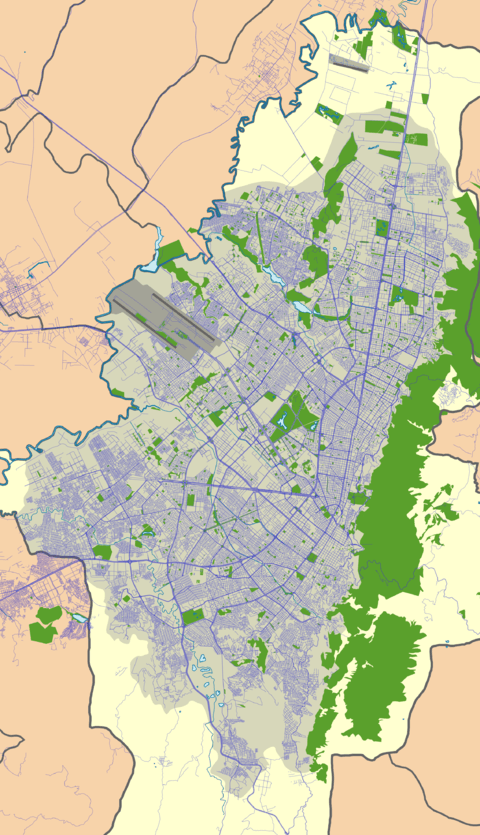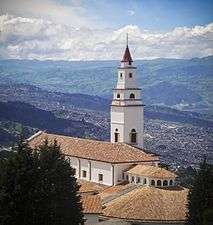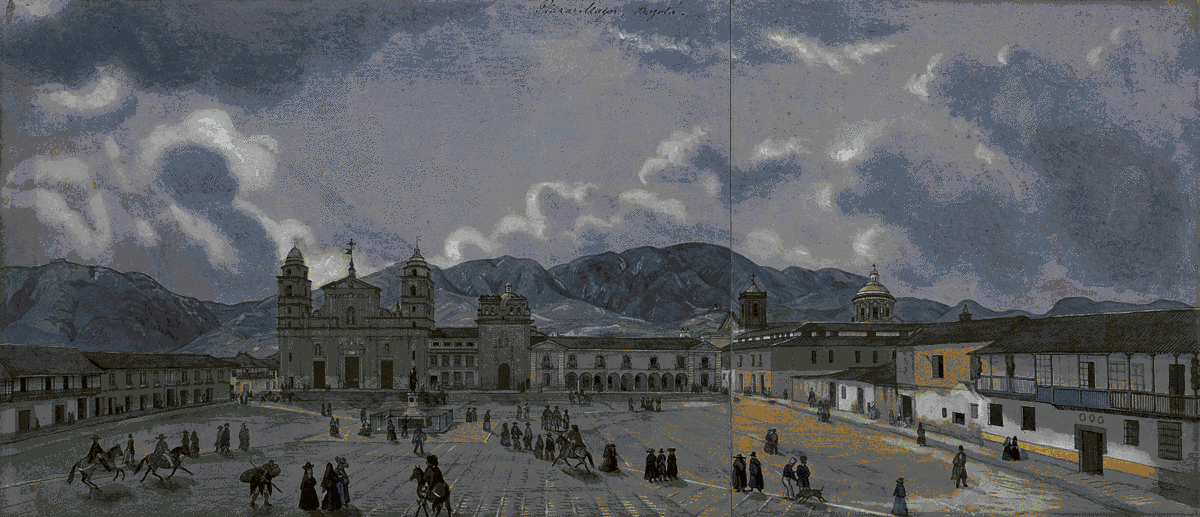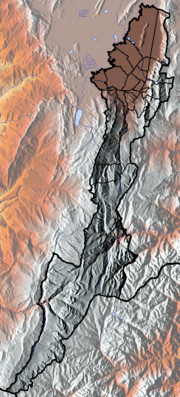Monserrate
Monserrate (named after Catalan homonym mountain Montserrat) is a high Mountain over 10,000 feet high that dominates the city center of Bogotá, the capital city of Colombia. It rises to 3,152 meters (10,341 ft) above the sea level, where there is a church (built in the 17th century) with a shrine, devoted to El Señor Caído ("The Fallen Lord").
| Monserrate | |
|---|---|
 | |
| Highest point | |
| Elevation | 3,152 m (10,341 ft) |
| Coordinates | 4°36′21″N 74°3′23″W |
| Geography | |
 Monserrate Location within Bogotá | |
| Country | Colombia |
| Region | Cundinamarca |
| Provinces | |
| Settlement | Bogotá, Colombia |
| Parent range | Eastern Hills Altiplano Cundiboyacense Eastern Ranges Andes |
| Climbing | |
| First ascent | Pre-Columbian era |
| Easiest route | Funicular Teleférico de Monserrate Pilgrimage trail |
The Mountain, already considered sacred in pre-Columbian times when the area was inhabited by the indigenous Muisca, is a pilgrim destination, as well as a major tourist attraction. In addition to the church, the summit contains restaurants, cafeteria, souvenir shops and many smaller tourist facilities. Monserrate can be accessed by aerial tramway (a cable car known as the teleférico), by funicular, or by climbing, the preferred way of pilgrims. The climbing route was previously closed due to wildfires and landslides caused by a drought, but it reopened in 2017.
All downtown Bogotá, south Bogotá and some sections of the north of the city are visible facing west, making it a popular destination to watch the sunset over the city. Every year, Monserrate and its neighbour Guadalupe attract many tourists.
History
Pre-Columbian era
The history of Monserrate goes back to the pre-Columbian era. Before the Spanish conquest, the Bogotá savanna was inhabited by the Muisca, who were organised in their loose Muisca Confederation. The indigenous people, who had a thorough understanding of astronomy, called Monserrate quijicha caca; "grandmother's foot".[1] At the solstice of June, the Sun, represented in their religion by the solar god Sué, rises exactly from behind Monserrate, as seen from Bolívar Square.[2] The Spanish conquistadors in the early colonial period replaced the Muisca temples by catholic buildings. The first primitive cathedral of Bogotá was constructed on the northeastern corner of Bolívar Square in 1539, a year after the foundation of the capital of the New Kingdom of Granada.
Colonial period

In the 1620s, the Cofradia de la Vera Cruz ("Brotherhood of Vera Cruz") began using the Monserrate's hill top for religious celebrations. As time passed, many devoted residents of Bogotá began participating in the climb to the hill top. In 1650, four gentlemen met with the Archbishop as well as Juan de Borja, the head of the Tribunal of Santafe de Bogotá, in order to secure permission to build a small religious retreat on the top of Monserrate. The founders decided to establish the hermitage retreat in the name of Monserrat's Morena Virgin. Her sanctuary was located in Catalonia, near Barcelona, giving the mountain the name Monserrate. Some people believe Montserrat was chosen to be the patron saint, due to one of the founders, Pedro Solis, having an uncle who had previously served as abbot in the Montserrat sanctuary.
By 1656, Father Rojas had been assigned guarding the sanctuary and ordered the carving of a crucifix and a statue of Jesus Christ. After this statue was taken off the cross, it earned the name El Señor Caído ("The Fallen Lord"). Originally, these sculptures were placed inside a small chapel dedicated to the adoration of Christ instead of being placed inside the religious retreat itself. As time passed, more and more people began visiting the sanctuary in order to see the statue of Jesus, rather than the matron saint of Monserrat. By the 19th century, the statue of "The Fallen Lord" had gained so much attention, that the sculpture to the Virgin of Montserrat was removed from the hill as the center piece of the sanctuary and replaced with "El Señor Caido". The mountain has retained the name Monserrate afterwards. Ever since then, for more than four centuries, pilgrims and citizens have hiked the mountain to offer their prayers to the shrine of "El Señor Caido".
Tourism
Both Monserrate and its neighbor Guadalupe Hill are icons of Bogota's cityscape. The hill is a tourist attraction with access by funicular or cable car (both of which charge a fee) or the pilgrimage hiking trail (free).[3] The hiking path is 2.4 km (1.5 mi), over which the elevation increases 0.6 km (1,968 feet).[4][5] The average grade of steepness is 25 percent.
Funicular
- Monday to Friday: 7:00 to 11:45 am
- Saturday: 7:00 to 4:00 pm
- Sunday: 5:30 to 5:00 pm
- Holidays: 6:30 to 11:45 am
Teleférico de Monserrate cable car
- Monday-Saturday: 12 pm to 12:00 am
- Sundays: 9:00 to 5:00 pm
Gallery
.jpg) Guadalupe seen from Monserrate
Guadalupe seen from Monserrate Top of Monserrate
Top of Monserrate Monserrate Monastery
Monserrate Monastery Monserrate Monastery
Monserrate Monastery.jpg) Cable car on Monserrate
Cable car on Monserrate Cable car
Cable car
See also
References
- Bonilla Romero et al., 2017, p.153
- Bonilla Romero, 2011, p.14
- (in Spanish) Touristic information Monserrate
- Garcia, Brian (2019-01-16). "Experience Cerro Monserrate Bogotá Hike In Colombia". BE Adventure Partners. Retrieved 2020-01-31.
- "Hiking the Cerro de Monserrate, Bogota". Free Two Roam. 2019-10-06. Retrieved 2020-01-31.
Bibliography
- Bonilla Romero, Julio H.; Edier H. Bustos Velazco, and Jaime Duvan Reyes. 2017. Arqueoastronomía, alineaciones solares de solsticios y equinoccios en Bogotá-Bacatá - Archaeoastronomy, alignment solar from solstices and equinoxes in Bogota-Bacatá. Revista Científica, Universidad Distrital Francisco José de Caldas 27. 146-155. Accessed 2017-01-18.
- Bonilla Romero, Julio H. 2011. Aproximaciones al observatorio solar de Bacatá-Bogotá-Colombia - Approaches to solar observatory Bacatá-Bogotá-Colombia. Azimut, Universidad Distrital Francisco José de Caldas 3. 9-15. Accessed 2017-01-18.
External links
| Wikimedia Commons has media related to Monserrate. |


.svg.png)